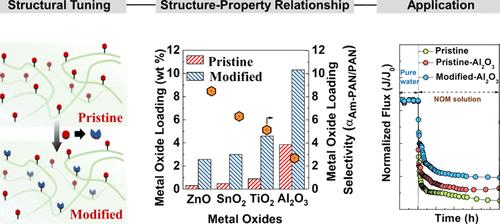当前位置:
X-MOL 学术
›
Chem. Mater.
›
论文详情
Our official English website, www.x-mol.net, welcomes your feedback! (Note: you will need to create a separate account there.)
Tailoring the Interfacial Interactions of Porous Polymer Membranes to Accelerate Atomic Layer Deposition: The Latent Path to Antifouling Membranes
Chemistry of Materials ( IF 8.6 ) Pub Date : 2024-04-05 , DOI: 10.1021/acs.chemmater.3c03090 Rahul Shevate 1 , Vepa Rozyyev 1 , Rajesh Pathak 1 , Anil U. Mane 1 , Kirti Sankhala 2 , Feng Gao 3 , Tamar Segal-Peretz 2 , Seth B. Darling 3 , Jeffrey W. Elam 1
Chemistry of Materials ( IF 8.6 ) Pub Date : 2024-04-05 , DOI: 10.1021/acs.chemmater.3c03090 Rahul Shevate 1 , Vepa Rozyyev 1 , Rajesh Pathak 1 , Anil U. Mane 1 , Kirti Sankhala 2 , Feng Gao 3 , Tamar Segal-Peretz 2 , Seth B. Darling 3 , Jeffrey W. Elam 1
Affiliation

|
Atomic layer deposition (ALD) is a powerful strategy to engineer hybrid organic–inorganic membranes with emergent functionalities. The combination of atomic-level thickness control, a wide materials palette, and unprecedented conformality allows the physiochemical properties (e.g., hydrophilicity) of mesoporous polymer membranes to be precisely tuned. The nucleation of ALD material growth on polymer surfaces relies on Lewis acid–base interactions and remains an overlooked motif with tremendous potential to accelerate ALD nucleation and growth. Strategies to enhance these interactions could enable desirable properties such as antifouling behavior to be imparted on inert polymer surfaces that lack the necessary functional groups for ALD nucleation. In this study, we demonstrate that the reactivity of polyacrylonitrile (PAN) membranes toward ALD metal oxide (MO) precursors with Lewis acid characteristics is enhanced by introducing strong Lewis base functional groups (amidoxime: Am) on the PAN backbone (Am-PAN). The resulting Lewis acid–base interactions accelerate the MO nucleation in Am-PAN and reduce the number of deposition cycles required to achieve hydrophilicity compared with the untreated PAN membrane. Unveiling the reaction mechanism, in situ Fourier transform infrared (FTIR) spectroscopy measurements established enhanced interaction dynamics between the ALD MO precursors and the Am-PAN membrane, unlike the PAN membrane. Spectroscopic ellipsometry and thermogravimetric analysis measurements revealed higher MO loadings in Am-PAN membranes compared to PAN membranes for the same number of ALD cycles. We found that strong Lewis acid–base interactions accelerated the ALD for a range of materials including Al2O3, TiO2, SnO2, and ZnO. More broadly, our work demonstrates that tailoring metal–precursor–polymer interactions is a powerful strategy to accelerate and modulate the ALD. We used this design strategy to fabricate Al2O3–Am-PAN hybrid membranes that showed 2-fold higher antifouling capability compared to pristine PAN membranes prepared with an equivalent number of Al2O3 ALD cycles. Our approach expands the scope of design options for fouling-resistant porous hybrid inorganic–organic membranes and may ultimately reduce the operational costs of water treatment.
中文翻译:

调整多孔聚合物膜的界面相互作用以加速原子层沉积:防污膜的潜在途径
原子层沉积(ALD)是设计具有新兴功能的有机-无机杂化膜的强大策略。原子级厚度控制、广泛的材料选择和前所未有的共形性的结合使得介孔聚合物膜的物理化学性质(例如亲水性)得以精确调节。 ALD 材料在聚合物表面生长的成核依赖于路易斯酸碱相互作用,并且仍然是一个被忽视的主题,具有加速 ALD 成核和生长的巨大潜力。增强这些相互作用的策略可以使缺乏 ALD 成核所需官能团的惰性聚合物表面具有所需的性能,例如防污行为。在这项研究中,我们证明,通过在 PAN 主链 (Am-PAN) 上引入强路易斯碱官能团(偕胺肟:Am),聚丙烯腈 (PAN) 膜对具有路易斯酸特性的 ALD 金属氧化物 (MO) 前体的反应性得到增强。与未经处理的 PAN 膜相比,由此产生的路易斯酸碱相互作用加速了 Am-PAN 中的 MO 成核,并减少了实现亲水性所需的沉积循环次数。与 PAN 膜不同,原位傅里叶变换红外 (FTIR) 光谱测量揭示了反应机理,增强了 ALD MO 前体和 Am-PAN 膜之间的相互作用动力学。光谱椭圆光度法和热重分析测量表明,对于相同数量的 ALD 循环,Am-PAN 膜中的 MO 负载量高于 PAN 膜。我们发现强路易斯酸碱相互作用加速了一系列材料的 ALD,包括 Al 2 O 3、TiO 2、SnO 2和 ZnO。更广泛地说,我们的工作表明,定制金属-前体-聚合物相互作用是加速和调节 ALD 的强大策略。我们使用这种设计策略来制造 Al 2 O 3 –Am-PAN 杂化膜,与使用相同数量的 Al 2 O 3 ALD 循环制备的原始 PAN 膜相比,其防污能力提高了 2 倍。我们的方法扩大了防污多孔混合无机-有机膜的设计选择范围,并可能最终降低水处理的运营成本。
更新日期:2024-04-05
中文翻译:

调整多孔聚合物膜的界面相互作用以加速原子层沉积:防污膜的潜在途径
原子层沉积(ALD)是设计具有新兴功能的有机-无机杂化膜的强大策略。原子级厚度控制、广泛的材料选择和前所未有的共形性的结合使得介孔聚合物膜的物理化学性质(例如亲水性)得以精确调节。 ALD 材料在聚合物表面生长的成核依赖于路易斯酸碱相互作用,并且仍然是一个被忽视的主题,具有加速 ALD 成核和生长的巨大潜力。增强这些相互作用的策略可以使缺乏 ALD 成核所需官能团的惰性聚合物表面具有所需的性能,例如防污行为。在这项研究中,我们证明,通过在 PAN 主链 (Am-PAN) 上引入强路易斯碱官能团(偕胺肟:Am),聚丙烯腈 (PAN) 膜对具有路易斯酸特性的 ALD 金属氧化物 (MO) 前体的反应性得到增强。与未经处理的 PAN 膜相比,由此产生的路易斯酸碱相互作用加速了 Am-PAN 中的 MO 成核,并减少了实现亲水性所需的沉积循环次数。与 PAN 膜不同,原位傅里叶变换红外 (FTIR) 光谱测量揭示了反应机理,增强了 ALD MO 前体和 Am-PAN 膜之间的相互作用动力学。光谱椭圆光度法和热重分析测量表明,对于相同数量的 ALD 循环,Am-PAN 膜中的 MO 负载量高于 PAN 膜。我们发现强路易斯酸碱相互作用加速了一系列材料的 ALD,包括 Al 2 O 3、TiO 2、SnO 2和 ZnO。更广泛地说,我们的工作表明,定制金属-前体-聚合物相互作用是加速和调节 ALD 的强大策略。我们使用这种设计策略来制造 Al 2 O 3 –Am-PAN 杂化膜,与使用相同数量的 Al 2 O 3 ALD 循环制备的原始 PAN 膜相比,其防污能力提高了 2 倍。我们的方法扩大了防污多孔混合无机-有机膜的设计选择范围,并可能最终降低水处理的运营成本。



























 京公网安备 11010802027423号
京公网安备 11010802027423号